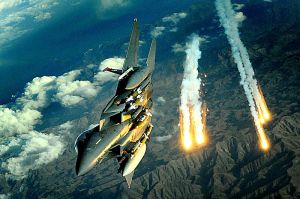U.S. Prepares For New Decade Of War In Asia
Rick Rozoff
The United States is engaged in the longest war in its 234-year history in Afghanistan, one that will begin its eleventh calendar year in two weeks. Like the war that had been America's longest before now, that in Indochina, the current one is in the Asian continent.
With repeatedly extended projected withdrawal dates, the latest is 2014, although even that has been characterized by Pentagon spokesman Geoff Morrell as merely "aspirational," the campaign in Afghanistan and over the past two years in neighboring Pakistan has marked Asia as the center of U.S. global military strategy and operations.
Roughly 100,000 U.S. troops and over half as many more from Washington's North Atlantic Treaty Organization allies and partners are waging an armed conflict that this year has resulted in an increasing number of civilian casualties and the most deaths among belligerents on both sides since it began on October 7, 2001. U.S. and NATO war dead this year are approaching the 700 mark, nearly a third of the total for the over nine-year-old war.
Last month the U.S. and NATO flew 850 combat sorties, three times more than in November of last year. From January through November of this year foreign occupation forces' aircraft have conducted 30,000 close air support missions for troops on the ground. In the last six months U.S. and NATO forces have launched 7,000 special operations missions in Afghanistan. [1] NATO helicopter gunships have also increased raids inside Pakistan, including one in September that killed three Pakistani border troops.
Central Intelligence Agency-directed drone missile attacks in Pakistan have risen to at least 108 so far this year, more than double the 53 strikes in 2009. The amount of deaths caused by the attacks has also doubled, over 800 compared to 400 the preceding year.
The Pentagon and its NATO allies have established a military presence on bases in several other nations in Central and South Asia, including - publicly - Kyrgyzstan, Tajikistan and Uzbekistan and without official acknowledgement in Pakistan, Kazakhstan and Turkmenistan.
In doing so the U.S. and the expansionist military bloc it controls have established a network of troops and bases in a swathe of territory with China to the east, Russia to the north and Iran to the west.
The expanding circle of military influence and infrastructure extends to India, with whom the U.S. leads bilateral and multinational naval, air and infantry/armor exercises in both countries, as well as pulling the world's second most populous nation into the orbit of military interoperability through large-scale weapons transactions.
In Mongolia, U.S. Pacific Command and U.S. Army Pacific lead annual Khaan Quest military exercises with the host country's armed forces and those of assorted American NATO and Asian allies in preparation for deployments to war zones like Iraq and Afghanistan. This year's Khaan Quest included troops from - in addition to the U.S. and Mongolia - Canada, France, Germany, India, Japan, Singapore and South Korea.
In addition to countries in the Asia-Pacific region with which the U.S. maintains Cold War-era defense treaties - Australia, Japan, the Philippines, New Zealand, South Korea and Thailand - the Pentagon has recently conducted military exercises and training in South and Southeast Asia nations like Bangladesh, Singapore, Vietnam, Sri Lanka, Indonesia, East Timor, Brunei, Malaysia and Cambodia.
Last July the U.S. led the two-week Angkor Sentinel military exercise in Cambodia with troops from 26 nations including Britain, France, Germany, Italy, Australia, India, Indonesia, Japan, Mongolia and the Philippines, described by Prime Minister Hun Sen as "a symbol of the strong military ties between the US and Cambodia." [2]
U.S. Army Pacific will lead a follow-up exercise, Angkor Sentinel 2011, in Cambodia next May.
(Note: You can view every article as one long page if you sign up as an Advocate Member, or higher).





